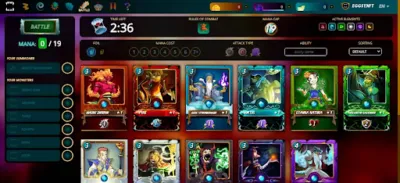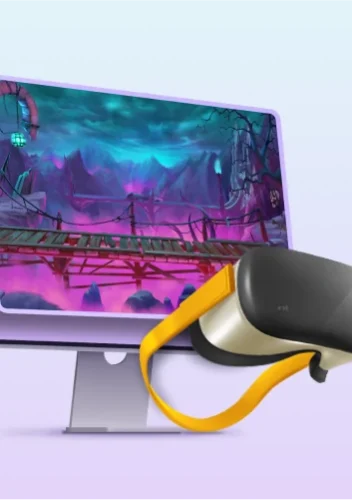What is GameFi?
The integration of blockchain technology and gaming has become a hit in recent years. In January 2021, blockchain games and their infrastructure attracted around $1 billion of investments.
GameFi is one of the manifestations of this trend. It refers to the combination of the latest crypto developments with the classic thrill of winning prizes. GameFi players can lend, trade, or even rent out their winnings. The number of GameFi applications is growing at an astounding pace, as the figures below suggest.

So, what is GameFi? Why is it gaining popularity? What are the best GameFi games? Read on to find out the answers to these questions and more.
GameFi Definition
To understand what GameFi stands for, we have to start with the term DeFi. The latter originates from the phrase “decentralized finance,” referring to token-based transactions on the decentralized digital ledgers (blockchains).
The word “GameFi” is usually used to describe dapps — decentralized applications with economic incentives. In such applications, performing some game-related tasks (winning battles, mining resources, etc.) is rewarded with tokens. Unlike traditional in-game currencies, those tokens have real value outside the gaming environment. That’s why this approach is also called play-to-earn.
Many GameFi apps also allow users to earn money passively. For example, they can let others mine their digital lands. Moreover, users can earn money by lending their assets (characters, for instance) or depositing them (staking).
How does GameFi work?
We’ve covered some basics, but we still need to learn more to answer the question “What is GameFi crypto, and how does it work?” Here are some details.
Play-to-earn model
Play-to-earn approach at the core of GameFi projects is the exact opposite of the traditional pay-to-play model. The latter implies that gamers have to invest money before they can start playing. Usually, traditional video games don’t offer any financial rewards to players. The gaming company controls its in-game assets. The players of P2E games have full control over their assets. Moreover, they can be used to make money.
Tangible rewards for virtual achievements
Players can get their reward in many forms: cryptocurrencies or in-game assets (weapons, land, avatars, costumes, and so on). The GameFi projects differ in the ways they build their game economies. Most often, the in-game assets are NFTs (non-fungible tokens) on the blockchain, stored in personal wallets. Therefore, players can trade them on NFT marketplaces. However, they may also be required to convert those assets into an NFT before making any transactions.
Those assets tend to provide some benefits to the players, allowing them to earn more rewards. Still, in some cases, they can serve as purely visual decorations with no influence on the earnings or gameplay.
Rewards are earned by completing tasks, building monetized assets, or competing with other players. As we have already mentioned, getting income even without actually playing the game is also possible.
Note, however, that the GameFi projects can differ significantly in the model and game design they adopt. Blockchain usually allows players to control their in-game assets. Nonetheless, that isn’t always the case. Also, keep in mind that some GameFi projects require initial investments in NFTs to start playing.
Benefits of GameFi
We’ve figured out GameFi what is, so now we’ll focus on its advantages. You may infer some of them from the previous sections, but let’s name them clearly:
- Gamers can monetize their efforts. The use of blockchain technologies and NFTs enables gamers to earn money in the process of playing. Thus, games on blockchain can also offer new employment opportunities.
- Gamers own their digital assets. Virtual costumes, weapons, characters, etc., have not only real value but also clearly defined owners. Blockchain technology provides reliable ways to verify ownership. Moreover, the gamers can easily and securely trade their assets
- Games become more user-centered. Gaming companies don’t always own the sympathies of the gamers. For instance, they are accused of promoting sexist cultures and enticing users into paying for additional content. Ideally, the communities of users govern the GameFi apps, deciding on many things like fees
All those advantages for users contribute to the growing popularity of the GameFi metaverse. Therefore, it is a lucrative niche for both game developers and investors. As fan bases grow very quickly, an increasing number of companies turn to this industry. Also, new gaming platforms have emerged to help individuals and businesses create their own games with DeFi functionality.
Digital asset ownership
We’ve already mentioned that blockchain technology is the key to establishing digital asset ownership. Let’s have a closer look at this feature as it provides players with different ways to monetize their in-game assets.
Both traditional and blockchain video games allow players to own avatars, weapons, tools, dwellings, and much more. However, in GameFi projects, these assets emerge as NFTs in the blockchain. Hence, players get full control over their assets with ensured authenticity and verifiable ownership.
Some popular games (The Sandbox, Decentraland) focus on virtual land ownership. Players can earn money for their digital lands. The Sandbox allows gamers to purchase in-game real estate, developing them to get revenue. Other players may have to pay for visiting their land. Owners can rent their customized land or get rewards for hosting content and events.
Top-5 GameFi Projects
Among hundreds of GameFi dapps, some are more popular than others and generate a larger volume of transactions. According to DappRadar, just two projects, DeFi Kingdoms and Axie Infinity, were responsible for almost half of January 2022 game dapps transactions.

Here are five of the most renowned and fastest-growing GameFi projects.
DeFi Kingdoms

DFK has recently captured the attention of GameFi experts, dimming the star of the industry behemoth, Axie Infinity. Its nostalgic pixelated digital multiverse creates an authentic gaming experience.
From the technical point of view, DFK is a DeFi protocol with contracts enabling a decentralized exchange, liquidity, and staking pools, as well as an NFT marketplace. In the game, those attributes are represented by such concepts as the bank, the tavern, or the gardens. There the DFK’s utility and governance token called JEWEL is required.
JEWEL can be staked in the bank or used to purchase the Hero NFTs or game avatars in the tavern. The Kingdom’s marketplace allows trading game items in order to boost the player’s level. The gardens enable DFK’s liquidity pools.
Axie Infinity

Axie Infinity is one of the world’s biggest blockchain based games. In mid-April 2022, it boasted more than 100k monthly users. Its play-to-earn features include property trading and task completion. Game progress requires players to train, collect, and fight NFT-creatures called Axies.
For dedicated players, Axie Infinity can be a source of substantial income. Top gamers earn as much as hundreds of thousands monthly. Even an average player can expect to get $400 over the same time. AXS cryptocurrency can also serve to support that income. Its market capitalization exceeds $8 billion.
The Sandbox

The Sandbox multiverse boasts an astounding two mln registered users. It is an Ethereum-based, decentralized gaming community allowing creators and players to share and monetize ‘voxel’ assets as well as gaming experiences.
A dramatic 10,000% in the value of the Sandbox token, $SAND, is another testimony to its success. This boom has attracted even more new users. The platform provides players and creators with free software to create in-game assets and experiences. The latter are placed in a marketplace and offer players a source of passive income.
Alien Worlds

Alien Worlds is an NFT metaverse gaming project, providing various missions using unique digital assets in the form of NFTs. As of mid-April 2022, it was ranked second in the Games category by DappRadar. The number of its monthly users was estimated at 850k, with a whopping 70% increase over this period.
Players who compete with one another and complete missions earn Trillium tokens ($TLM). It can open access to special missions taking players to various planets in the Alien Worlds universe.
Players can form teams to take on different missions, define planetary politics, create NFT drops, or design custom missions.
What sets Alien World apart is its cross-chain bridge feature. With its help, players can move to and from other blockchain networks, such as the BNB Chain and Ethereum, using Metamask.
Splinterlands

Splinterlands was ranked as a top gaming dapp by DappRadat in mid-April. With 580 mln monthly users, it is one of the most popular GameFi projects.
It is a vivid representative of the next-generation collectible card games. Splinterlands allows players to buy and sell unique digital cards. The project’s governance token, $SPS, can be used to upgrade to a new level of decision-making and get control over the available products.
How do GameFi companies make money?
We’ve found how using GameFi apps can be a source of income for gamers. But what about game creators? What’s in it for them?
In our blog, we’ve described how to make money with NFT. These are the ways to monetize dapp projects:
- Crowdsale and token launch. A popular business and revenue model. A project can be bootstrapped through crowdsale and then backed with a token. If the game is a success and a lot of people play it and trade the coins, their prices go up. Thus, token-holders, including game creators, make more money.
- Transaction fees. Charging users for specific transactions can also be a source of revenue.
- Premium. You can offer players an opportunity to upgrade their game by buying access to some functions using digital currency.
- Subscription. A subscription or membership element can be used to ensure that the specific function has only been called upon only by a specific group of users.
- Design virtual Goods. You can create generation 0 of some unique in-game items and offer them to the users for their collections. If you make them unique, functional. and enticing enough, the users will be willing to invest their money into buying them.
- Advertisements. While not a very common blockchain monetization model, it can still be used to generate money.
- Donations. Though hardly predictable in the level of generated income, this option can also be taken into consideration.
Build your own GameFi project together with Whimsy Games!
The GameFi industry has a huge potential thanks to its unique benefits for players. Built around the Blockchain technology, such projects allow gamers to own their in-game assets and to trade them or use them in other ways to get some passive income. Moreover, they provide users with much greater control over gameplay than traditional games. As such games grow in popularity, so do the revenues of their creators.
If you are planning to start a GameFi project, Whimsy Games can help you. We are one of the top blockchain game development companies. Our team accumulated profound skills and experience while working on dozens of projects in this sphere. We keep an eye open for the latest industry trends and will find a toolset fitting your requirements precisely. Contact us, and we’ll be glad to discuss your ideas.


















